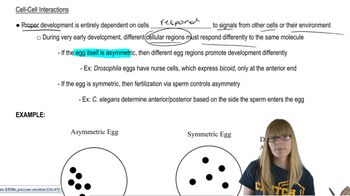The variable gene activity hypothesis states that cell differentiation and determination is controlled through differences in gene activation or inactivation.
Table of contents
- 1. Introduction to Genetics51m
- 2. Mendel's Laws of Inheritance3h 37m
- 3. Extensions to Mendelian Inheritance2h 41m
- 4. Genetic Mapping and Linkage2h 28m
- 5. Genetics of Bacteria and Viruses1h 21m
- 6. Chromosomal Variation1h 48m
- 7. DNA and Chromosome Structure56m
- 8. DNA Replication1h 10m
- 9. Mitosis and Meiosis1h 34m
- 10. Transcription1h 0m
- 11. Translation58m
- 12. Gene Regulation in Prokaryotes1h 19m
- 13. Gene Regulation in Eukaryotes44m
- 14. Genetic Control of Development44m
- 15. Genomes and Genomics1h 50m
- 16. Transposable Elements47m
- 17. Mutation, Repair, and Recombination1h 6m
- 18. Molecular Genetic Tools19m
- 19. Cancer Genetics29m
- 20. Quantitative Genetics1h 26m
- 21. Population Genetics50m
- 22. Evolutionary Genetics29m
14. Genetic Control of Development
Studying the Genetics of Development
Problem 2
Textbook Question
Bird beaks develop from an embryonic group of cells called neural crest cells that are part of the neural tube, which gives rise to the spinal column and related structures. Amazingly, neural crest cells can be surgically transplanted from one embryo to another, even between embryos of different species. When quail neural crest cells were transplanted into duck embryos, the beak of the host embryo developed into a shape similar to that found in quails, creating the 'quck.' Duck cells were recruited in addition to the quail cells to form part of the quck beak. Conversely, when duck neural crest cells were transplanted into quail embryos, the beak of the embryo resembled that of a duck, creating a 'duail,' and quail cells were recruited to form part of the beak. What do these experiments tell you about the autonomy or nonautonomy of the transplanted and host cells during beak development?
 Verified step by step guidance
Verified step by step guidance1
Understand the concept of cell autonomy: Cell autonomy refers to whether a cell's fate and behavior are determined by its own genetic programming (autonomous) or influenced by external signals from its environment (nonautonomous).
Analyze the experiment where quail neural crest cells were transplanted into duck embryos: The resulting 'quck' beak resembled the quail beak, indicating that the transplanted quail cells retained their intrinsic genetic programming to shape the beak. This suggests that the quail cells are largely autonomous in determining beak shape.
Consider the recruitment of duck cells in the 'quck' beak: The fact that duck cells were recruited to form part of the quck beak indicates that the transplanted quail cells influenced the duck cells. This suggests that the quail cells exerted nonautonomous effects on the duck cells, guiding their contribution to the beak structure.
Analyze the experiment where duck neural crest cells were transplanted into quail embryos: The resulting 'duail' beak resembled the duck beak, indicating that the transplanted duck cells retained their intrinsic programming to shape the beak. This again suggests that the transplanted cells are largely autonomous in determining beak shape.
Summarize the findings: These experiments demonstrate that the transplanted neural crest cells are primarily autonomous in determining the overall shape of the beak, but they also exhibit nonautonomous effects by influencing the host cells to contribute to the beak's development.
 Verified video answer for a similar problem:
Verified video answer for a similar problem:This video solution was recommended by our tutors as helpful for the problem above
Video duration:
2mPlay a video:
Was this helpful?
Key Concepts
Here are the essential concepts you must grasp in order to answer the question correctly.
Neural Crest Cells
Neural crest cells are a unique group of cells that emerge from the neural tube during embryonic development. They are multipotent, meaning they can differentiate into various cell types, including those that form facial structures like beaks. Their ability to migrate and contribute to different tissues is crucial for understanding how physical traits develop and can be influenced by genetic and environmental factors.
Recommended video:
Guided course

Cell-cell interactions
Cell Autonomy vs. Nonautonomy
Cell autonomy refers to the ability of a cell to develop and function independently, without influence from neighboring cells. In contrast, nonautonomy indicates that a cell's fate and behavior are influenced by its environment or surrounding cells. The experiments with quail and duck neural crest cells illustrate these concepts, as the transplanted cells can dictate the beak shape, suggesting a level of nonautonomy in the host cells' development.
Recommended video:
Guided course

Cell-cell interactions
Transplantation Experiments
Transplantation experiments involve moving cells or tissues from one organism to another to study developmental processes and cellular interactions. In the context of the beak development experiments, these transplants reveal how donor cells can influence the morphology of the host organism, providing insights into the genetic and developmental mechanisms that govern physical traits and the plasticity of embryonic development.
Recommended video:
Guided course

Mendel's Experiments

 8:30m
8:30mWatch next
Master Genetics of Development with a bite sized video explanation from Kylia
Start learningRelated Videos
Related Practice
Multiple Choice
675
views
2
rank
